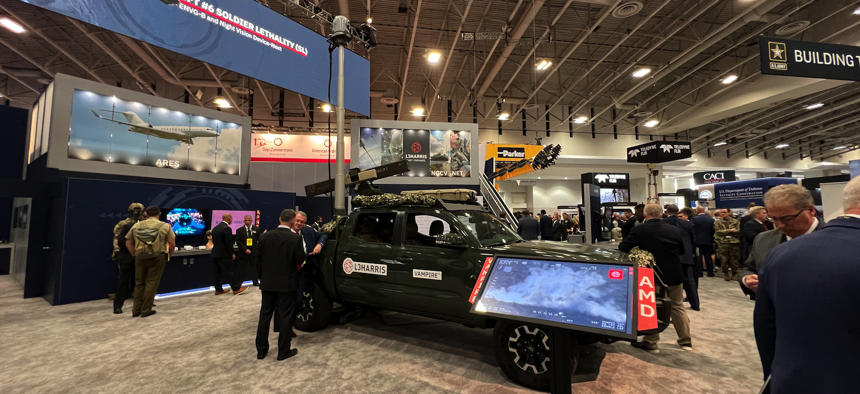
L3Harris’s VAMPIRE on display at the Association of the U.S. Army’s annual convention Defense One / Marcus Weisgerber
Here Is the Counterdrone Kit the US Is Sending Ukraine
Made by L3Harris Technologies, the system can be quickly installed on different types of vehicles.
A counterdrone weapon that the Pentagon recently said it would send to Ukraine is a compact combination of three systems already used by the U.S. Army: a jammer, an infrared camera, and a rocket launcher, executives said.
L3Harris Technologies showed off the system, called VAMPIRE, at the Association of the U.S. Army’s annual meeting in Washington.
“We did this to address some open operational needs, that some of our sensitive customers kind of had out there in terms of a real solution to take care of real threats, in a kinetic way that guarantees if you can see it that you at least [can] take care of the problem,” said Luke Savoie, president of L3Harris’ Intelligence Surveillance and Reconnaissance business.
Russia has used loitering munitions—also known as kamikaze drones—to strike inside Ukraine. In late August, U.S. officials announced they would send the system to Ukraine.
L3Harris engineers combined the jammer, camera, and launcher into a kit that has been tested upon a variety of vehicles, Savoie said. At AUSA, a demonstration unit was mounted on a Toyota Tacoma pickup truck.
Installation on a vehicle typically takes about a couple of hours and it can be easily removed when it's not needed, according to L3Harris. A soldier in the passenger seat can control the entire system with a joystick and screen.
The company plans to add a radar to the system, said Bob Shelala, an L3Harris representative.
“The beauty in this system is, it is very low-dollar comparatively [and] easy to put in any vehicle,” Shelala said.
L3Harris began developing the system about two years ago. The original vision was to use it to take out enemy air defenses. The company modified the rocket’s proximity fuze to be able to strike drones, Savoie said.
“We’re spiraling into more capability as we refine the cameras and refine the weapon systems,” Shelala said.





